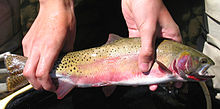
Trout is a generic common name for numerous species of carnivorous freshwater ray-finned fishes belonging to the genera Oncorhynchus, Salmo and Salvelinus, all of which are members of the subfamily Salmoninae in the family Salmonidae. The word trout is also used for some similar-shaped but non-salmonid fish, such as the spotted seatrout/speckled trout.

The cutthroat trout is a group of four fish species of the family Salmonidae native to cold-water tributaries of the Pacific Ocean, Rocky Mountains, and Great Basin in North America. These four species are the Coastal, Westslope, Lahontan, and the Rocky Mountain. As a member of the genus Oncorhynchus, it is in the Pacific trout group, which includes the widely distributed rainbow trout. Cutthroat trout are popular gamefish, especially among anglers who enjoy fly fishing. The common name "cutthroat" refers to the distinctive red coloration on the underside of the lower jaw. The specific name clarkii was given to honor explorer William Clark, coleader of the Lewis and Clark Expedition.

Oncorhynchus is a genus of ray-finned fish in the subfamily Salmoninae of the family Salmonidae, native to coldwater tributaries of the North Pacific basin. The genus contains twelve extant species, namely six species of Pacific salmon and six species of Pacific trout, all of which are migratory mid-level predatory fish that display natal homing and semelparity.

The yellowfin cutthroat trout is an extinct subspecies or variety of the cutthroat trout, a North American freshwater fish.

Lahontan cutthroat trout is the largest subspecies of cutthroat trout and the state fish of Nevada. It is one of three subspecies of cutthroat trout that are listed as federally threatened.

The greenback cutthroat trout is the easternmost subspecies of cutthroat trout. The greenback cutthroat, once widespread in the Arkansas and South Platte River drainages of Eastern Colorado and Southeast Wyoming, today occupies less than 1% of its historical range. It is currently listed as threatened under the Endangered Species Act. It was adopted as the state fish of Colorado on March 15, 1994, replacing the unofficial rainbow trout.
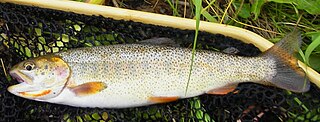
The Snake River fine-spotted cutthroat trout is a form of the cutthroat trout that is considered either as a separate subspecies O. c. behnkei, or as a variety of the Yellowstone cutthroat trout. The fish takes its common name from its original habitat, the Snake River of southern Idaho and western Wyoming, and from its unusual pattern of hundreds of small spots that cover most of its body, differing from the larger-spotted Yellowstone cutthroat pattern. Genetically, it cannot be distinguished from the Yellowstone cutthroat trout, and before the construction of dams, no physical barriers were between the ranges of the two subspecies in the Snake River drainage.
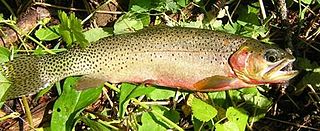
The westslope cutthroat trout, also known as the black-spotted trout, common cutthroat trout and red-throated trout is a species of the cutthroat trout group and is a freshwater fish in the salmon family of order Salmoniformes. The cutthroat is the Montana state fish. This subspecies is a species of concern in its Montana and British Columbia ranges and is considered threatened in its native range in Alberta.
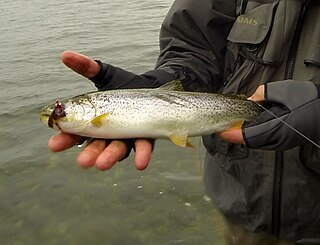
The coastal cutthroat trout, also known as the sea-run cutthroat trout, blue-back trout or harvest trout, is one of the four species of cutthroat trout found in Western North America. The coastal cutthroat trout occurs in four distinct forms. A semi-anadromous or sea-run form is the most well known. Freshwater forms occur in both large and small rivers and streams and lake environments. The native range of the coastal cutthroat trout extends south from the southern coastline of the Kenai Peninsula in Alaska to the Eel River in Northern California. Coastal cutthroat trout are resident in tributary streams and rivers of the Pacific basin and are rarely found more than 100 miles (160 km) from the ocean.

Paiute cutthroat trout is one of fourteen subspecies of cutthroat trout. Paiute Cutthroat are native only to Silver King Creek, a headwater tributary of the Carson River in the Sierra Nevada, in California. This subspecies is named after the indigenous Northern Paiute peoples.
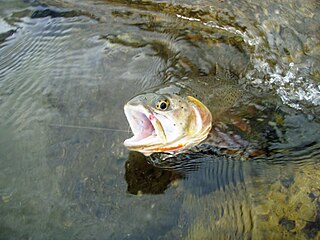
The cutbow is an interspecific fertile hybrid between rainbow trout and cutthroat trout. While natural separation of spawning habitat limited hybridization in most native populations of rainbow and cutthroat trout, introduction of non-native hatchery-raised rainbow trout into native cutthroat trout range increased hybridization across the landscape. Due to these introductions, many populations of cutthroat trout are at risk of genetic pollution. As a result, significant management intervention at state and federal levels has occurred to preserve native populations of cutthroat trout.

Kawuneeche Valley, also known as Kawuneeche or Coyote Valley, is a marshy valley of the Colorado River near its beginning. It is located on the west side of Rocky Mountain National Park in Colorado. The axis of the valley runs almost directly north to south. Kawuneeche means "valley of the coyote" in Arapaho language and there is a Coyote Valley Trail head by US Route 34 in the western half of the park. Coyotes still live here, as do wapiti (elk), mule deer, moose, and mountain lion.
The Baja California rainbow trout or San Pedro Martir trout or Nelson's trout is a localized subspecies of the rainbow trout, a freshwater fish in the family Salmonidae.
The Humboldt cutthroat trout is a subspecies of cutthroat trout, a North American fish in the family Salmonidae. It is one of the several subspecies of cutthroat trout. It was formally scientifically named in 2008 by Trotter and Behnke, who stated its distribution is in the basins of the upper Humboldt River of northern Nevada, the Upper Quinn River, as well as the Whitehorse (Coyote) basin (Oregon). The Nevada and Oregon Fish and Wildlife authorities still consider these populations belonging to the subspecies O. c. henshawi.
The Willow-Whitehorse Basin cutthroat trout refers to a population segment of the cutthroat trout complex from the streams of the Whitehorse Basin, southeastern Oregon. It is alternatively considered as a part of the Lahontan cutthroat trout subspecies, or of the Humboldt cutthroat trout whose main range is in Nevada. These fish have adapted to live under extreme conditions, and can withstand water temperatures as high as 85 °F for short periods of time.

Dr. Robert J. Behnke was an American fisheries biologist and conservationist who was recognized as a world authority on the classification of salmonid fishes. He was popularly known as "Dr. Trout" or "The Trout Doctor". His seminal work, Trout and Salmon of North America, was published in 2002. He wrote a regular column for Trout Magazine, the quarterly publication of Trout Unlimited. He was a fisheries biologist with the U.S. Fish and Wildlife Service in the Colorado Cooperative Fish and Wildlife Research Unit and a professor at Colorado State University in the 1970s. He became a Professor Emeritus at the Department of Fishery and Wildlife Biology at Colorado State University.

Costilla Creek is a tributary of the Rio Grande in Colorado and New Mexico.
Fishing in Colorado has brought in a large amount of revenue for the state. In 2019 Colorado Parks and Wildlife estimated outdoor recreation contributed roughly 62 billion dollars to the state economy. Fishing was reported to be the 5th most popular outdoor activity and 110, 511 fishing and hunting combination licenses were sold. Ice fishing makes up part of this total fishing revenue and is a common annual sport for Colorado residents and out-of-state visitors. There is no legal definition of ice fishing season. Rather, people begin to ice fish once the lakes freeze over with thick enough ice. Colorado Parks and Wildlife also recommend that people always ice-fish with another person. Typically, this starts in December and ends in April for Colorado. Lakes size, depth, elevation, and seasonal weather can cause variance to the season. Once the lakes freeze over with thick enough ice, anglers go out onto the ice, drill holes through the ice, and fish for a variety of species.

The Rocky Mountain cutthroat trout(Oncorhynchus virginalis), formerly lumped in with the cutthroat trout as one species with multiple subspecies, is a fish species of the family Salmonidae native to cold-water tributaries of the northern and southern Rocky Mountains, as well as into portions of the Great Basin in North America. As a member of the genus Oncorhynchus, it is a part of the Pacific trout group, which includes the widely distributed rainbow trout. Cutthroat trout are popular gamefish, especially among anglers who enjoy fly fishing. The common name "cutthroat" refers to the distinctive red coloration on the underside of the lower jaw.
